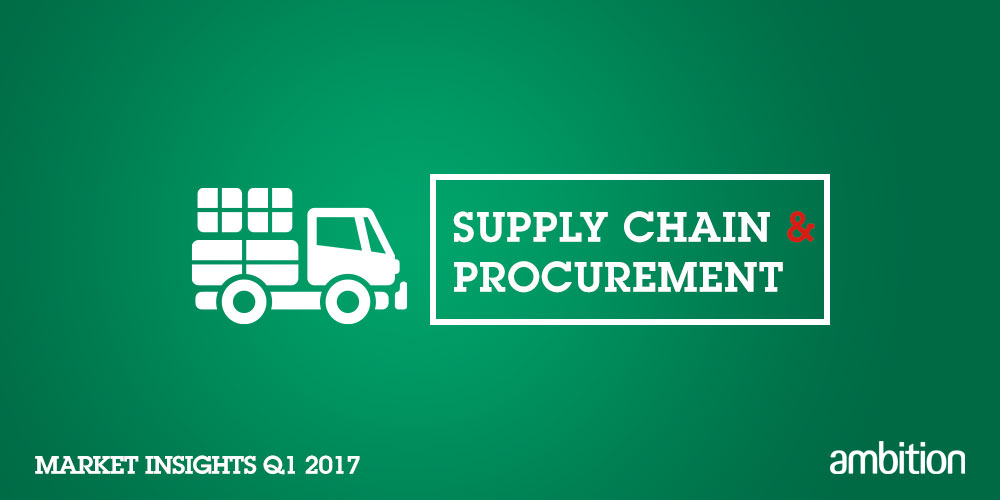Market Insights Report 2025
Explore the latest hiring trends and in-demand skills shaping the employment landscape in 2025 to guide your hiring strategies or job search.

Explore the latest hiring trends and in-demand skills shaping the employment landscape in 2025 to guide your hiring strategies or job search.

Explore the latest hiring trends and in-demand skills shaping the employment landscape in 2025 to guide your hiring strategies or job search.

Explore the latest hiring trends and in-demand skills shaping the employment landscape in 2025 to guide your hiring strategies or job search.



Talent demand within the Supply Chain & Procurement domain in Singapore continues to vary with an uncertain economic outlook for the future.
In 2016, there was a continuing outflow of manufacturing facilities to more cost-effective locations across South-East Asia. Business focus has been on managing costs for procurement talent as most hires tended to revolve around replacement hiring rather than newly created positions.
We saw the continuous growth of the e-Commerce space, and along with this, a strong demand for talent for those with direct-to-consumer and last mile delivery experience. Logistics businesses also faced intense competition for experienced professionals with project management and implementation experience.
Additionally in Healthcare industry, there was demand for talented professionals with deep knowledge and experience in cold chain, as well as supply & demand planning and forecasting.
We saw significant hiring demand within the pharmaceutical, medical device and consumer goods industries for supply chain professionals with leadership experience. The 3PL industry was seeing promising growth, providing career opportunities for talents with experience in end-to-end supply chain.
There was a downward trend in hiring in the industrial sector, with redundancies in Oil & Gas and Technology industries resulting in an increased supply of talent versus limited demand in this area.
Moving into Q1 2017, we expect a continuing trend where Direct Procurement jobs are being moved to low-cost locations across South East Asia, with an increase in manufacturing facilities across Vietnam, Malaysia, Thailand and Indonesia. This will conversely affect demand for lower-skilled manufacturing and logistics professionals in Singapore.
We also see businesses having a continued demand for indirect procurement professionals at all levels of experience, especially those with specialised experience in marketing, HR and IT.
Integrated supply chain solutions providers are also seeing an upward curve in business growth, and the talent demand in this space is set to continue into 2017.
Supply Chain & Logistics |
|
|
|
Job title | Years of experience | Singapore | Malaysia |
|
| Annual salary range (S$) | Annual salary range (RM$) |
Supply Chain | |||
Head of Supply Chain | 18+ | 220K–300K | 300K–500K |
Regional Supply Chain Director / VP | 15+ | 150K–180K | 250K–400K |
Supply Chain Director / VP | 12+ | 120K–160K | 200K–280K |
Supply Chain Manager | 8–12 | 90K–120K | 150K–220K |
Assistant Supply Chain Manager | 6–8 | 60K–100K | 100K–180K |
Senior Supply / Demand Planner | 4–6 | 50K–80K | 80K–140K |
Supply / Demand Planner | 3–5 | 55K–75K | 80K–120K |
Logistics / Warehouse / Operations | |||
Head of Logistics / Warehouse Operations | 18+ | 180K–240K | 260K–420K |
Regional Director / VP | 15+ | 160K–200K | 220K–360K |
Director / VP | 12+ | 140K–180K | 240K–300K |
Regional Manager | 7–10 | 100K–140K | 180K–240K |
Manager | 5–8 | 60K–80K | 95K–130K |
Assistant Manager | 3–5 | 50K–70K | 80K–120K |
Procurement / Purchasing | |||
Head of Procurement | 15+ | 220K–300K | 300K–500K |
Director / VP | 12+ | 150K–260K | 250K–280K |
Senior Manager | 10+ | 100K–180K | 180K–400K |
Manager | 8–10 | 80K–130K | 120K–200K |
Assistant Manager | 5–7 | 60K–80K | 95K–130K |
*Notes about salary table:
Titles and levels vary from organisation to organisation.
The salary ranges given are only approximate guides. For tailored salary advice, please contact us directly.
12-month base salaries are assumed.
All other benefits and bonuses are in addition to these figures.
Bonus ranges can vary significantly from company to company and will be influenced by market conditions, business and individual performances. Bonus ranges from 1 month at the low end to 100%+ at the upper.
Holiday entitlements range from 12–25 days with senior executives not usually receiving less than 18 days. Less than 15 is very rare and 20 days is becoming the norm.
Healthcare policies are standard.
Pension plans vary with some companies offering greater than the standard contribution. Top up schemes can increase employer contribution levels as much as 15– 20% of the base salary for senior executives.